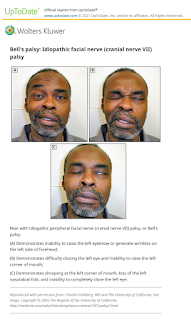Bell Palsy
Introduction
Bell palsy is a subacute weakness of the facial nerve.
- It may be due to idiopathic or secondary to herpes infections (likely cause in most cases).
Evaluation
Diagnosis is made clinically. Patients typically present with an acute onset of unilateral facial weakness, which may result in an asymmetric smile or trouble fully closing the eyelids.
- Onset is acute, over a day or two; the course is progressive, reaching maximal clinical weakness/paralysis within 3 weeks or less from the first day of visible weakness; and recovery or some degree of function is present within 6 months.
Secondary causes of peripheral facial weakness should be distinguished (e.g. Lyme disease, parotid gland tumours, Guillain-Barre syndrome, stroke)
Management
Recommend eye protection if the patient cannot fully close the eye.
- May include lubrication (eye drop or ointment) and eyelid taping.
Offer corticosteroid to patients with new-onset (usually ≤72 hours) to increase the likelihood of a full recovery.
- Oral prednisolone 60 mg once daily for 5 days, then taper dose downward by 10 mg daily for 5 days; OR
- Oral prednisolone 50 mg daily (in 1 or 2 divided doses) for 10 days.
It remains uncertain whether antiviral therapy adds benefit to glucocorticoids in patients with new-onset Bell's palsy, despite many trials and good rationale.
- Antiviral therapy should not be offered as the sole therapy.
- Consider oral antiviral therapy in addition to oral steroids within 72 hours of symptom onset, particularly in patients with severe-to-complete paresis or in children with a vesicular rash on presentation.
Consider adding facial exercise therapy to pharmacologic therapy to improve functional outcomes.
Prognosis
The prognosis of Bell palsy is very good.
- Complete recovery to normal facial function occurs in approximately 70% of untreated cases, with permanently impaired facial function occuring to a minor degree in 13% and to a major degree in 16% of cases. Rates of complete recovery increase to approximately 80-85% with glucocorticoid treatment.
- Of those who present with incomplete paralysis on clinical examination, 94% will fully recover, as compared to 61% of those who present with complete paralysis.
External Links
- The natural history of Bell's palsy, 1982
- Bell's palsy: the spontaneous course of 2,500 peripheral facial nerve palsies of different etiologies, 2002
- Corticosteroids for Bell's palsy (idiopathic facial paralysis), 2016
- Antiviral treatment for Bell's palsy (idiopathic facial paralysis), 2019
- Evaluation of Factors Associated With Favorable Outcomes in Adults With Bell Palsy, 2020

Comments
Post a Comment